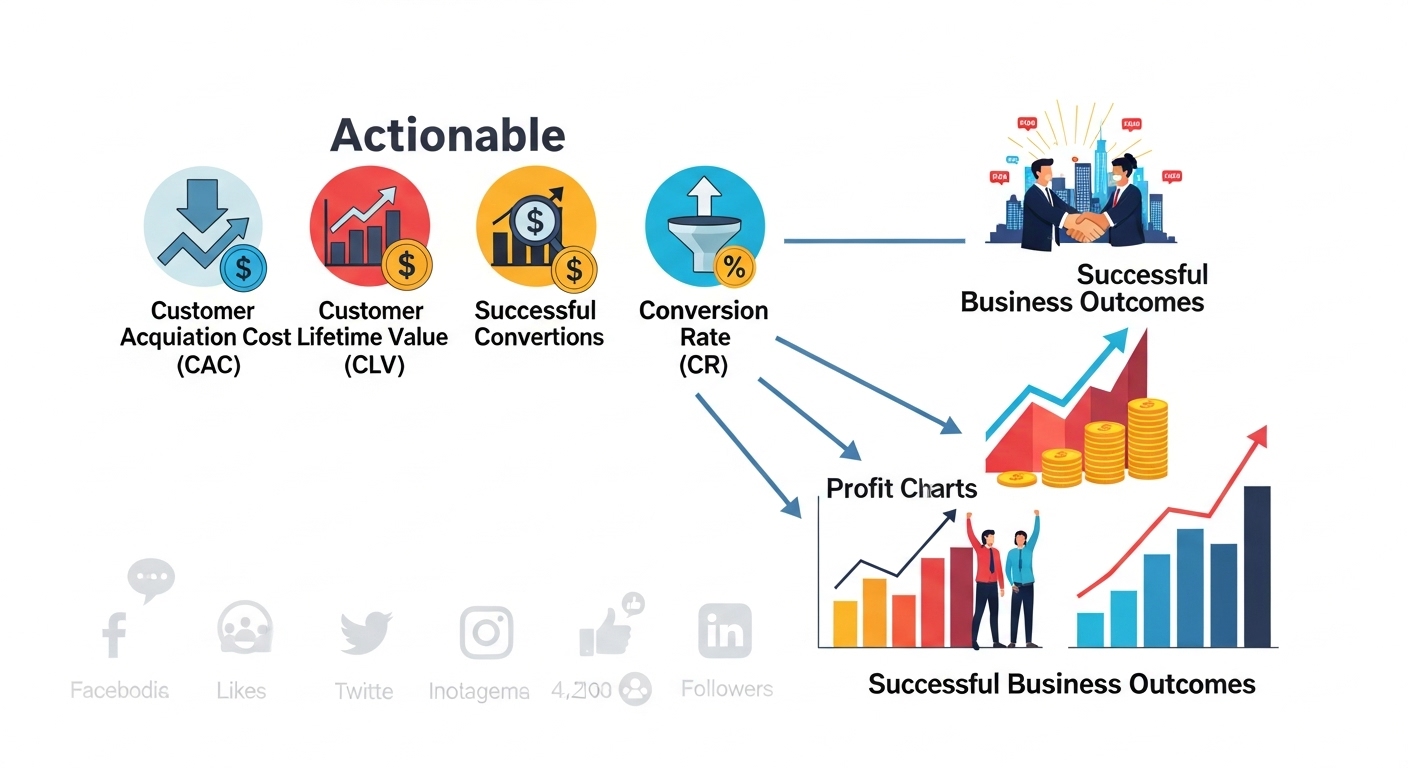Digital Marketing ROI: Measure True Value, Ditch Vanity Metrics
Executive Summary: The Mandate for Measurable Marketing
The contemporary digital landscape demands a fundamental re-evaluation of how marketing success is measured. A prevailing reliance on superficial “vanity metrics” has emerged as a significant impediment to strategic growth, budget justification, and true business impact. This report presents a comprehensive framework for transitioning to a value-driven measurement model, one that directly connects digital marketing activities to tangible outcomes such as leads, conversions, and quantifiable revenue.
A core conclusion is that the shift from vanity to business metrics is not merely an analytical adjustment; it is a profound strategic and cultural imperative. A lack of actionable data leads directly to flawed decision-making, an inability to accurately prove marketing’s contribution, and the misallocation of financial and human resources. Conversely, the implementation of a robust, data-driven framework allows for continuous campaign optimization, effectively proving marketing’s value as a core driver of business growth and sustainable revenue. This report synthesizes key findings on the strategic importance of moving to business metrics, the necessity of aligning marketing and sales efforts, the limitations inherent in last-click attribution, and the pivotal role of first-party data and artificial intelligence in navigating a rapidly evolving, privacy-first future.
Part 1: The ROI Illusion – Why Likes and Shares Aren’t Enough
1.1 The Pitfalls of Popularity: Deconstructing Vanity Metrics
Vanity metrics are defined as quantifiable data points that, while appearing impressive, offer little to no actionable guidance for future strategies or business improvement. These are statistics that make a company “look good to others” but fail to provide the necessary context to inform performance and drive growth. Common examples include raw pageviews, the total number of social media followers, likes on a post, and the running total of registered accounts or customers. On the surface, a metric like 10,000 total registered accounts seems impressive, but it loses all meaning if only 100 of those users are active on a monthly basis. The core problem with these metrics is that they are misleading, simplistic, and lack the nuance required for meaningful analysis.
The pervasive use of vanity metrics is often a symptom of a larger organizational problem. These metrics are “easy to obtain” and often free, providing a convenient shortcut for marketing professionals who are under pressure to “show immediate success to superiors”. This creates a culture that prioritizes outward appearance over internal, data-driven improvement, a dynamic that hinders a company from reaching its strategic goals. The data indicates that vanity metrics “don’t help you improve your product or business in a meaningful way”. A business that values impressive but hollow numbers over nuanced, actionable insights is ultimately prioritizing short-term validation over long-term strategic health. The problem is not merely an analytical one; it is a top-down cultural issue that requires a deliberate shift in focus from “looking good” to “driving revenue.” This organizational misalignment is a critical barrier to achieving true marketing ROI and directly connects to the later discussion on aligning marketing and sales.
The danger of vanity metrics is not simply that they are “empty digits”. They actively lead to the misallocation of resources and a warped sense of success. The research explicitly states that these indicators “can seduce organizations, leading them off course”. For example, a Facebook post that receives 10,000 likes may result in fewer sales than a post that receives only one like. This lack of correlation between engagement and revenue demonstrates that optimizing a campaign for “likes” instead of conversions is a direct path to wasted time and budget. The causal chain is clear: misinterpreting superficial engagement as a proxy for success leads to poor strategic decisions and an investment in campaigns that do not contribute to the bottom line.
1.2 The Shift to Business Value: Defining Actionable Metrics
In direct contrast to vanity metrics, actionable metrics are those that provide the context and nuance necessary to inform business decisions and contribute to organizational goals. These metrics directly link marketing activities to revenue and business health. Instead of tracking raw pageviews, for example, a company should focus on metrics that reveal user behavior and content quality, such as bounce rate, time spent on a page, and pages per session. The following are key business metrics that are essential for measuring marketing’s true impact:
- Customer Acquisition Cost (CAC): The total marketing expenditure required to acquire a new, paying customer over a specific period.
- Customer Lifetime Value: The total net profit a company earns from a customer over the entire duration of their relationship. This metric gauges a customer’s long-term value and is a critical indicator of brand loyalty.
- Conversion Rate: The percentage of visitors who complete a desired action. This can be segmented into website conversion rate (visitors to leads) and sales conversion rate (Marketing Qualified Leads to paying customers).
- Return on Ad Spend (ROAS): A metric that directly measures the revenue generated for every dollar spent on a specific ad campaign. The formula is given as: ROAS = (Revenue from Campaign) / (Cost of Ad Spend).
These actionable metrics are foundational to a mature marketing strategy because they provide a direct feedback loop on what is working and what is not. The true value of a metric is its ability to inform a business decision, such as testing new ad copy, optimizing a landing page’s call-to-action (CTA), or shifting budget to a more profitable channel.

| Vanity Metric | Actionable Alternative(s) | Why it is Actionable |
|---|---|---|
| Pageviews | Bounce Rate, Time on Page, Click-Through Rate (CTR) | Informs decisions on content quality and user experience. |
| Total Followers | Engagement Rate by Demographic, Branded Search Lift | Shows if content is resonating with the target audience and building brand equity. |
| Total Registered Accounts | Active Monthly Users, Renewal Rate, Customer Retention Rate | Predicts long-term business health and reveals product/service stickiness. |
| Total Downloads | Spend per Order, Upgrade Rate | Connects a content asset directly to a revenue-generating outcome. |
Part 2: Connecting the Dots – From Campaign to Conversion and Revenue
2.1 The Customer Journey: A Multi-Stage Blueprint
Effective marketing measurement requires a clear understanding of the customer journey, which is a multi-stage process from initial awareness to final conversion. A structured digital marketing strategy must align campaigns with each of these stages to ensure measurable outcomes. The initial stage of Awareness is focused on driving traffic and brand visibility through channels such as social media, search engine optimization (SEO), and paid advertising (PPC). The Engagement stage aims to encourage interactions and lead capture through content marketing assets like blogs, whitepapers, and videos, as well as email marketing and optimized landing pages. Finally, the Conversion stage is where a lead becomes a customer, a process optimized by clear calls-to-action and lead nurturing.
2.2 Campaign Planning for Measurable Outcomes
A successful digital marketing campaign begins with defining clear, realistic, and measurable goals from the outset. The SMART goals framework is a foundational principle for this process, ensuring that objectives are Specific, Measurable, Achievable, Relevant, and Time-bound. A robust campaign plan must be structured with a clear media plan, a defined message hierarchy, and a system for checking progress against key performance indicators (KPIs). Without this structured approach, it is impossible to accurately assess performance and make informed decisions.
2.3 Aligning Marketing and Sales: The Revenue Marketing Imperative
The concept of “revenue marketing” is a strategic approach that unifies the sales and marketing teams to drive predictable revenue growth. It is a “holistic process” that moves beyond traditional siloed departmental goals. Achieving this alignment requires both teams to be fully aware of each other’s individual objectives and KPIs. A common language and strategy must be established, with CRM tools and workflow management systems serving as the foundation for seamless communication and real-time updates on lead progress.
This framework creates a self-improving, cyclical system of feedback and optimization. The process operates as a “constant and continuous loop of feedback” between sales and marketing teams. The relationship is not a linear handoff of leads, but rather a dynamic flow of information. Marketing generates leads, and the sales team nurtures them and provides real-time data back to marketing on how a lead is progressing through the deal stages. This sales data is then used by marketing to trigger “specific nurturing campaigns” and refine future strategies, ultimately leading to a more efficient and repeatable process for new customer acquisition. This continuous feedback loop is the engine of a truly mature, revenue-driven marketing operation.
The research provides compelling evidence that this alignment is not a luxury but a necessity for growth, with aligned organizations achieving “24% faster three-year revenue growth” and “38% higher sales win rates”.
- Customer Acquisition Cost (CAC)
- Formula: Total Marketing Cost / Number of New Customers
- Purpose & Strategic Insight: Measures the cost-effectiveness of acquisition efforts and helps optimize budget allocation.
- Customer Lifetime Value
- Formula: Avg. Purchase Value × Avg. Purchase Frequency × Avg. Customer Lifespan
- Purpose & Strategic Insight: Gauges the long-term value of a customer and informs decisions on customer retention strategies.
- Conversion Rate
- Formula: (Number of Conversions / Total Visitors) × 100%
- Purpose & Strategic Insight: Identifies the efficiency of a website, landing page, or sales funnel in turning visitors into leads or customers.
- Return on Ad Spend (ROAS)
- Formula: (Revenue from Campaign / Cost of Ad Spend)
- Purpose & Strategic Insight: Directly links ad spend to revenue generation for specific campaigns, enabling a clear view of short-term profitability.
Part 3: The Attribution Deep Dive – Unlocking the Full Customer Journey
3.1 Beyond the Last Click: The Flaws of Single-Touch Attribution
An attribution model is a framework for allocating credit for a conversion to the various marketing activities that influenced a customer’s decision to buy. For years, the most common approach has been single-touch attribution, primarily the last-touch model, which assigns 100% of the credit to the final interaction a customer had with a brand before converting. While this model is “easy to track” because it only requires focusing on the final touchpoint, it is fundamentally flawed.
The critical issue is that single-touch models “strip out the context” of the modern, complex customer journey. A customer may interact with a brand across multiple devices and channels, such as a social media ad, a blog post, an email, and a paid search click, before making a purchase. Last-touch attribution completely ignores these earlier interactions, leading to the assumption that the final touchpoint was solely responsible for the conversion. This can lead to a myopic, strategically dangerous worldview where a company over-focuses on bottom-of-funnel tactics, such as promotional emails, while undervaluing the brand awareness campaigns that made the sale possible in the first place. A marketing budget skewed heavily towards last-click winners can lead to a long-term decline in new customer acquisition and brand health, actively eroding a company’s growth potential by devaluing the very campaigns that create demand.
3.2 The Multi-Touch Spectrum: A Framework for Credit Allocation
Multi-touch attribution models were developed to provide a more complete and realistic picture of the customer journey, giving credit to every touchpoint that contributed to a conversion. These models enable marketers to make smarter budget decisions by identifying which efforts are “quietly doing a lot of heavy lifting”.
- Linear: This model gives equal credit to every touchpoint in the conversion path. While it provides a broader view than single-touch models, it has a significant flaw: it fails to show which touchpoints were most influential.
- Time Decay: This model assigns more credit to touchpoints that occurred closer to the final conversion, assuming that later interactions had more influence on the customer’s decision. It is a more comprehensive version of last-touch attribution.
- Position-Based: This family of models, including U-shaped and W-shaped, assigns more weight to specific, critical points in the journey. A common U-shaped model gives significant credit to both the first and last touchpoints, while a W-shaped model adds a third high-value touchpoint for “lead creation”.
3.3 The Frontier of Attribution: AI, MMM, and Incrementality
Beyond traditional models, the most advanced measurement strategies integrate the power of artificial intelligence and rigorous statistical methods. This creates a “multifaceted measurement strategy” that offers unparalleled accuracy and insight.
- Data-Driven Attribution (DDA): Powered by AI, this model represents the frontier of attribution. It uses a company’s past data to dynamically and accurately assign credit to each interaction across the conversion path. It is always on and continuously optimizes campaign performance in real-time. The industry has increasingly recognized its value, with Google making it the default for all Google Ads campaigns.
- Marketing Mix Modeling: This is a high-level, macro-level tool used to understand the long-term impact of marketing investments across all channels and to inform overall budget allocation decisions. MMM helps with strategic planning and is often used by C-level executives to justify investment.
- Incrementality Testing: This involves running controlled experiments to measure the incremental impact of a specific marketing activity on a desired outcome. By comparing a test group that was exposed to an ad with a control group that was not, marketers can prove with certainty that a campaign drove a customer action that would not have happened organically.
These three methods are not mutually exclusive. Instead, they work in concert: MMM helps plan the big picture budget allocation, incrementality validates specific tactical performance, and DDA optimizes real-time campaign execution.
- First-Touch
- Credit Distribution: 100% to first touchpoint
Strengths: Easy to implement; useful for measuring brand awareness and the effectiveness of top-of-funnel campaigns
Weaknesses: Overvalues the top of the funnel; ignores all subsequent interactions
Best Use Case: Simple marketing funnels or campaigns with a primary goal of brand awareness
- Last-Touch
- Credit Distribution: 100% to last touchpoint
Strengths: Easiest to track; provides clear data on what led to the final sale
Weaknesses: Overvalues the bottom of the funnel; ignores awareness and nurturing stages
Best Use Case: Campaigns with a primary goal of direct response or for simple, quick-sale funnels
- Linear
- Credit Distribution: Equal credit to all touchpoints
Strengths: Provides a more holistic view of the customer journey; easy to explain to stakeholders
Weaknesses: Does not show which touchpoints were most influential in the conversion
Best Use Case: Great for brands new to multi-touch attribution to get a broader understanding
- Time Decay
- Credit Distribution: More credit to touchpoints closer to the conversion
Strengths: Assumes later interactions have more influence; provides a more nuanced view than last-touch
Weaknesses: Still undervalues early, awareness-building touchpoints
Best Use Case: Businesses with shorter sales cycles or products with a fast consideration phase
- U-shaped
- Credit Distribution: 40% to first and last touch, 20% to middle
Strengths: Recognizes the importance of both initial awareness and final conversion
Weaknesses: Does not provide insight into the middle touchpoints of the journey
Best Use Case: Complex B2C journeys where first touch and last touch are clearly important
- Data-Driven
- Credit Distribution: Distributes credit based on historical data via AI
Strengths: Accurately reflects the actual contribution of each interaction; dynamic and always-on
Weaknesses: Requires a robust data foundation and sufficient conversion volume
Best Use Case: All campaigns where a company has sufficient data and a mature measurement framework
Part 4: Overcoming the Measurement Gap – Challenges and Solutions
4.1 The Data Silo Problem: Centralizing for a Holistic View
A primary obstacle to accurate ROI measurement is the problem of data silos. A data silo is a collection of data held by one group or department that is not easily accessible to others within the same organization. While a marketing department may have extensive data on campaign performance, a sales team may have crucial information on lead qualification and deal stages. This fragmentation makes it impossible to achieve the “360-degree view” of the customer necessary for accurate attribution and strategic planning. The consequences of siloed data are severe, leading to a limited view of performance, wasted resources, and a lack of collaboration between teams.
The core issue is that many companies capture vast amounts of data but “fail to connect it all”. Overcoming this challenge is both a technical and a cultural endeavor. From a technical standpoint, the solution lies in centralizing data from disparate sources into a single source of truth, such as a cloud-based data warehouse. This can be achieved using tools and processes that extract, transform, and load (ETL) data from various systems. Culturally, change management is required to encourage data sharing and collaboration, helping teams understand that the benefits of a holistic, enterprise-wide view outweigh the perceived security of departmental silos.
4.2 Navigating the Privacy-First Landscape
The digital marketing industry is in the midst of a seismic shift driven by tightening privacy regulations like the GDPR and CCPA, as well as the disappearance of third-party cookies. Major browsers such as Firefox and Safari have already blocked third-party cookies by default, and Google’s Privacy Sandbox is replacing personal tracking with a system that groups users into anonymous interest categories. This change presents a significant challenge for traditional measurement and attribution methods.
This change should not be seen as a threat to be mitigated but as a catalyst that is forcing the industry to evolve and mature.
The old, easy way of tracking users across the web is ending, forcing companies to confront their data silos and over-reliance on external data. The direct consequence is a strategic shift toward a “privacy-first” approach, focusing on building a robust first- and zero-party data strategy. This means collecting data directly from customers with their explicit consent through actions like email sign-ups and customer account creation. The data indicates that companies that embrace this approach can build a competitive advantage based on trust and transparency, leading to an average return of $160 for every $100 spent on privacy investments. This strategic shift is a prerequisite for a sustainable, effective measurement framework, as it provides the strong data foundation that modern analytics and AI platforms require to function effectively.
4.3 The Role of Technology: Tools and Platforms for Insight
Selecting the right technology stack is a critical step in building a mature measurement framework. The tools should be seen as an enabler of a robust data strategy, not the solution itself.
- Analytics Platforms: Tools like Google Analytics and Mixpanel provide the foundational data on website traffic, user behavior, and conversion tracking. They are essential for tracking actionable metrics like conversion rates, bounce rates, and user paths.
- Reporting and Integration Platforms: Services like AgencyAnalytics and HubSpot are designed to overcome the data silo problem by aggregating data from multiple channels into a single, customizable dashboard. These platforms streamline reporting, saving hours of manual effort and providing a unified view of performance.
- Advanced Solutions: Specialized tools and platforms exist for specific use cases, such as social media ROI (e.g., Sprout Social), content marketing ROI (e.g., CoSchedule), and PPC advertising ROI.
The right technology stack should be scalable, capable of integrating with other systems, and offer multi-channel attribution capabilities. This enables companies to automate data collection, standardize metrics, and visualize performance in real-time to make timely, data-driven decisions.
Part 5: Quantifiable Success – Real-World Case Studies and Best Practices
5.1 From Theory to Practice: Case Studies of Strategic Shifts
The principles outlined in this report are not merely theoretical; they are validated by real-world, quantifiable success stories. These case studies serve as the ultimate proof point for the report’s entire thesis, demonstrating a direct causal link between a strategic shift and a measurable, positive financial impact.
- Peet’s Coffee: By revamping its Google Ads strategy to focus on high-ROI keywords and align ad copy with searcher intent, Peet’s Coffee achieved a 455% increase in revenue and a 158% increase in Return on Ad Spend (ROAS). This case demonstrates the power of shifting from a broad, stagnant approach to a highly targeted, data-driven paid search strategy.
- McDonald’s Hong Kong: The company leveraged the advanced analytics capabilities of Google Analytics 4 to gain insights into user behavior, leading to a remarkable 550% increase in in-app orders. This highlights the value of using a modern analytics platform to understand the customer journey and optimize the user experience on an app.
- The North Face: By implementing Google Tag Manager 360, The North Face was able to improve conversion measurement and website efficiency, resulting in a 3X boost in conversions. This example shows that proper implementation and consistent technical tracking are essential, transforming a seemingly small change into a significant ROI.
- A B2C Website Landing Page: A case study of a website that was underperforming on a key search term demonstrated that small, data-informed changes can yield significant results. By conducting A/B tests on landing page design and messaging, the company was able to increase its conversion rate by an impressive 67%.
These examples transform abstract concepts like attribution and analytics into tangible business outcomes. The evidence is clear: a strategic shift toward a mature measurement framework is a business imperative, not a marketing luxury.
5.2 The Action Plan: A Checklist for Marketing Leaders
Based on the synthesis of these principles and case studies, a clear, step-by-step action plan for marketing leaders emerges:
- Set SMART Goals: Start every campaign and initiative by defining clear, measurable, and relevant objectives that align with overall business goals.
- Ditch Vanity Metrics: Consciously shift focus away from superficial indicators like likes and shares toward actionable metrics that directly inform business decisions, such as CLV, CAC, and conversion rates.
- Audit Your Data Infrastructure: Identify and break down data silos that prevent a holistic view of the customer journey. Centralize data from disparate sources into a single source of truth.
- Adopt a First-Party Data Strategy: In response to a privacy-first landscape, prioritize the collection of first- and zero-party data with explicit user consent.
- Embrace Multi-Touch Attribution: Move beyond the simplistic last-click model and adopt a multi-touch framework that accurately credits every touchpoint in the customer journey.
- Align Marketing and Sales: Establish a “revenue marketing” culture where sales and marketing teams share goals and KPIs, enabling a continuous feedback loop and more efficient lead nurturing.
- Invest in the Right Technology and Talent: Select analytics platforms and reporting tools that are scalable, offer multi-channel attribution, and provide customizable dashboards to visualize data effectively.
- Foster a Data-Driven Culture: Encourage a company-wide commitment to using data to inform decisions, turning ROI measurement into a strategic endeavor rather than a mere financial exercise.
Conclusion: The Strategic Imperative of ROI Measurement
The journey from tracking vanity metrics to measuring true business value is a transformative one. It requires a strategic and cultural commitment that transcends a single campaign or marketing initiative. As this report has demonstrated, effective ROI measurement is not defined by a simple formula or a single tool. It is a comprehensive framework that integrates clear objectives, a unified data infrastructure, sophisticated attribution modeling, and cross-functional alignment.
Ultimately, the true return on investment in digital marketing is not found in a spreadsheet of likes and shares, but in the sustainable, predictable revenue growth that only a truly data-driven organization can achieve. By adopting a mature measurement strategy, marketing leaders can move beyond proving their value to becoming a foundational driver of business success.
📚 For more insights, check out our ultimate digital marketing resource.


